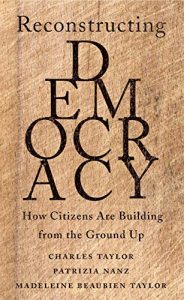In Reconstructing Democracy: How Citizens are Building from the Ground Up, Charles Taylor, Patricia Nanz and Madeleine Beaubien Taylor respond to the lack of public faith in the institutions of representative democracy by calling for a ‘bottom-up’ reconstruction of democracy at the local level, drawing on examples of local participatory democracy in action. While the book explores some inspiring initiatives that can have real and lasting benefits for communities and the capacity to solve local problems, Luke Bostian is unconvinced that such programmes alone can address the wider structural forces that jeopardise efforts to reconstruct democracy.
Reconstructing Democracy: How Citizens are Building from the Ground Up. Charles Taylor, Patricia Nanz and Madeleine Beaubien Taylor. Harvard University Press. 2019.
 On 25 May 2020, a protest broke out in Minneapolis, Minnesota, after the killing of a Black man, George Floyd, by a police officer. In the months since, the uprising has spread to dozens and then thousands of cities across the United States and around the world, many of which were met – as they had been in Minneapolis – by further police violence.
On 25 May 2020, a protest broke out in Minneapolis, Minnesota, after the killing of a Black man, George Floyd, by a police officer. In the months since, the uprising has spread to dozens and then thousands of cities across the United States and around the world, many of which were met – as they had been in Minneapolis – by further police violence.
To put it mildly, the people marching in the streets do not believe that the police represent their interests, or that the elected officials who oversee the police will listen to community demands for change. In that sense, they are an especially dramatic example of the lack of public faith in the institutions of representative democracy that has been a subject of interest for scholars since at least the 1970s. A recent entry to this literature of concern is Charles Taylor, Patricia Nanz and Madeleine Beaubien Taylor’s new book, Reconstructing Democracy.
Taylor et al are right to be concerned about the state of democratic institutions, and public attitudes towards them, in Europe, North America and beyond. While their motivations and goals vary widely, groups as diverse as the Gilets Jaunes in France (whose internal diversity of backgrounds and ideologies is itself startling); the student protesters who erupted in Chile in 2019 in outrage over a transportation fare hike and eventually demanded a new constitution; and the Black Lives Matter movement in the United States all accurately believe that their ostensibly democratic governments do not represent or respond equally to the needs of all citizens. At the same time, an anti-democratic backlash, in large part a reactionary response to efforts towards racial equality, has helped sweep into power right-wing authoritarians in ostensibly democratic countries, including Brazil, Hungary and the US, and led to historic electoral gains for far-right parties in Germany, the Netherlands and elsewhere.
The authors of Reconstructing Democracy lay the fault for this crisis at the feet of neoliberalism. They argue that the crisis of democracy has arisen because neoliberalism has separated economic affairs from social relationships and led to the rise of ‘managerial supremacy’ in the way democratic governments carry out their business. This has, in turn, led to a decline in the ability of traditional institutions to solve problems and a large gap between what people want government to do and what political elites think it should do.
But Taylor et al’s diagnosis stops short of examining why neoliberalism rose to the world-hegemonic status it enjoys today or addressing the idea that it might have arisen because it serves the purposes of particular groups of people. As a result, their neoliberalism, as discussed in the book’s introduction, is something of a mysterious, agency-less boogeyman. In fairness, this is a slim volume and clearly not meant to be a thorough academic interrogation of its core concepts. But given the emphasis they place on neoliberalism as the problem, the book would have been stronger if they had unpacked it further.
So much for the diagnosis. What about the prescription? Having identified low faith in institutions, poor institutional problem-solving capacity and a wide gap between the public and elected officials, Taylor et al call for a ‘bottom-up’ reconstruction of democracy based on four building blocks: an existential shift toward ‘empowering consciousness of collective agency and possibility’; new inclusive solidarities and trust; opening new alleys to creativity, ‘creating breakout innovation’; and alignment of goals, knowledge and motivation.
Quite rightly, the authors write about the value of these building blocks being not only in their ability to help people achieve defined goals, but also to conceive and go after future goals. What they are talking about is building people’s ‘capacity to aspire’: their ability to create and navigate a ‘map of a journey into the future’ in which their rights are fulfilled and they are able to thrive, in the words of the sociologist Arjun Appadurai. In the authors’ view, these building blocks are to be used first and foremost at the local level, to help communities work together with government officials and the private sector to define and solve local problems.
The three chapters that form the bulk of the book are based around examples of local participatory democracy in action, mostly from post-industrial cities in the US, Germany and Austria that had become depressed through the loss of manufacturing jobs that had formed the backbone of the municipal economy. All are instances when citizens had to define the problem to be addressed, not just come up with solutions to a given problem.
Some of the examples are inspiring. Chapter Two describes the redevelopment of San Diego Market Creek Plaza, a neighbourhood development project in which two local organisations formed paid outreach teams to create a shared vision and then worked with residents to form small committees that planned and implemented the project. Community members were then able to buy ‘shares’ in the project in a kind of ‘public IPO’. This move to ensure that ownership of capital in a community stays in the community is commendable and remarkable, and the authors are spot-on when they write ‘for neighborhood revitalization to be successful, residents must own process and assets’ (my emphasis).
Unfortunately, the prescriptions are as much plagued by shallowness and lack of evidence as the diagnosis. Little evidence is given for the outcomes and impacts of these initiatives on people’s quality of life or on the inclusiveness of their citizenship. The authors contend that infrastructure projects can serve as a means to strengthen democratic participation, but readers are mostly left guessing at any long- or even medium-term impacts on the towns and cities where the examples take place. They claim that ‘institutionalization of citizen participation […] is an important step toward establishment of participatory democracy’, but leave it at that. While they argue that participatory budgeting, of the kind pioneered in Brazil in the 1990s, is qualitatively different from the open-ended initiatives they have in mind, to me it seems to provide a rich context in which to consider the implications of institutionalisation. And in fact, participatory budgeting research shows that institutionalisation of citizen participation is not a uniform process, nor is it monolithically successful or positive. For example, it can lead to the softening and co-opting of radical movements that are seeking substantial changes to the status quo.
On that note, for a book about democracy, the diagnosis and prescriptions are curiously apolitical and technocratic. The ongoing popular uprisings against police brutality in the US show dramatically that conflicts at the municipal level are often deeply political fights about who wields power over whom and how. And the protests show that those in power do not generally give it up willingly or without a fight. But Reconstructing Democracy does not address the radical, confrontational activism that has so often been the driving force behind meaningful changes to democratic processes and rights, or the systematic assault on government institutions that is a defining feature of neoliberalism. For all the times the authors acknowledge that the initiatives they have in mind require the willing support of people in power, they do not explain why those people should or will render such support.
Finally, there is the very rosiness of the portraits the authors paint. Not until more than three-quarters of the way through the book are any participants shown to express negative reactions to a participatory process. While the authors do acknowledge here and there some of the challenges to ensuring genuine and inclusive participation, they make no reference to the rich scholarly literature on this issue. What they are proposing – expert-guided action research and dialogue with local residents and government officials in poor and deprived neighbourhoods – has strong parallels with what has been a standard international development practice for decades, with mixed results at best.
The authors of Reconstructing Democracy are not wrong that the initiatives they champion can have real and lasting benefits for people and their relationship with their governments, and on the capacity of local governments to address local problems. But I have my doubts that such programmes will be sufficient to make a dent in the deep and large-scale problems – racism; the authors’ own focus, neoliberalism; voter suppression – that threaten to cut any effort to reconstruct democracy off at the knees.
Please read our comments policy before commenting.
Note: This article is provided by our sister site, LSE Review of Books. It gives the views of the author, not the position of EUROPP – European Politics and Policy or the London School of Economics. Featured image credit: Steve Johnson CC BY 2.0
_________________________________
Luke Bostian
Luke Bostian is a Master’s student in Social Development Practice at University College London. Prior to beginning his graduate studies, he spent eleven years working in international development, most recently as Director of Policy and Partnerships for the Aga Khan Foundation, Pakistan.





